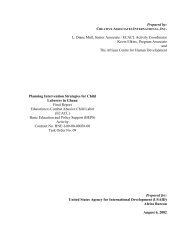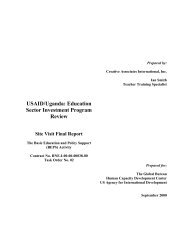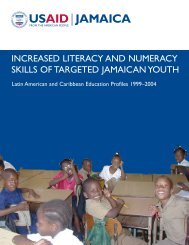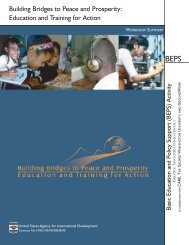Grandmothers: A Learning Institution - Basic Education and Policy ...
Grandmothers: A Learning Institution - Basic Education and Policy ...
Grandmothers: A Learning Institution - Basic Education and Policy ...
- No tags were found...
Create successful ePaper yourself
Turn your PDF publications into a flip-book with our unique Google optimized e-Paper software.
effects of the new ideas, their confidence intheir roles as family health advisor grew<strong>and</strong> they felt empowered to continue inthis role. One gr<strong>and</strong>mother put it this way,“The gr<strong>and</strong>mother activities have made usfeel much stronger than before. Now notonly do we have our traditional knowledge<strong>and</strong> experience, but we also have theknowledge of the doctors” (Ibid 18).This new level of confidence in the gr<strong>and</strong>mothers’role was reflected in the householdsreceiving advice. The mothers appreciatedthat the gr<strong>and</strong>mothers’ advice nowincluded both traditional <strong>and</strong> modern ideas,<strong>and</strong> furthermore, the mothers now felt thegr<strong>and</strong>mothers better understood theirneeds. The mothers also noted the visibleimprovements in their own health <strong>and</strong> thereduced burden of their daily activities dueto the new advice <strong>and</strong> support of thegr<strong>and</strong>mothers (Ibid 10).Additionally, at the household level thestudy found that the project resulted inincreased support from the husb<strong>and</strong>s forthe family’s health needs, improved relationshipsbetween mothers-in-laws <strong>and</strong> daughters-in-law,<strong>and</strong> strengthened relationshipsbetween gr<strong>and</strong>mothers <strong>and</strong> their gr<strong>and</strong>children(Ibid 10).The community leaders were also involvedin the strategy <strong>and</strong>, thus, impacted. As aresult of the project’s involvement ofgr<strong>and</strong>mothers, the formally-recognizedmale leaders acknowledged the role gr<strong>and</strong>mothershave in promoting maternal <strong>and</strong>child health <strong>and</strong> they learned about beneficialmaternal <strong>and</strong> child health practices.They also offered increased support for theadvice given by gr<strong>and</strong>mothers at thehousehold <strong>and</strong> community level (Ibid 8).Lastly, due to the positive outcomes of thegr<strong>and</strong>mother strategy at the different levelsdescribed above, noticeable changes wereobserved in the community-at-large includingstrengthened gr<strong>and</strong>mother networks,the increased involvement of those networksin promoting community health <strong>and</strong>increased support of gr<strong>and</strong>mothers toneighboring households, related to healthneeds.The evaluation concluded that the positivechanges at these four levels (gr<strong>and</strong>mothers,community leaders, households, <strong>and</strong> community-at-large),appear to be having acombined <strong>and</strong> positive effect on communitynorms related to the priority practicesconcerning infant <strong>and</strong> women’s health. Ofcourse, the process of changing communitynorms is a slow one, but the evidence suggeststhat such changes are beginning totake place.While policy planners <strong>and</strong> program practitionersare often skeptical about includinggr<strong>and</strong>mothers in child development initiatives,the feedback from communities <strong>and</strong>gr<strong>and</strong>mothers themselves, <strong>and</strong> the impactobserved, is a clear indication of the relevanceof such strategies.36 UNITED STATES AGENCY FOR INTERNATIONAL DEVELOPMENT







